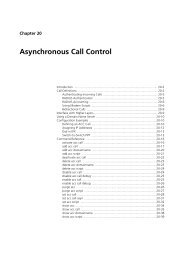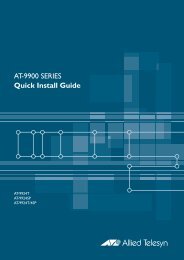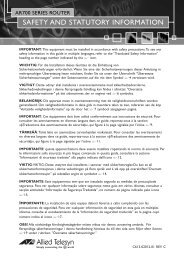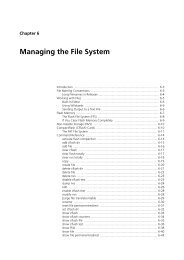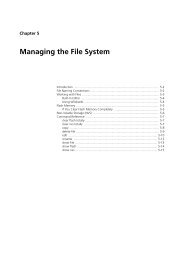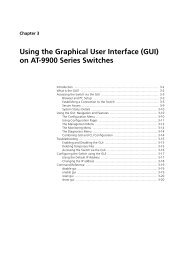Rapier Series Switch Hardware Reference - Allied Telesis
Rapier Series Switch Hardware Reference - Allied Telesis
Rapier Series Switch Hardware Reference - Allied Telesis
You also want an ePaper? Increase the reach of your titles
YUMPU automatically turns print PDFs into web optimized ePapers that Google loves.
<strong>Hardware</strong> <strong>Reference</strong> 33<br />
C613-03020-00 REV J<br />
PIC LEDs<br />
PICs are expansion options and must be purchased separately. They can only<br />
be used if an AT-AR040 NSM is installed in the switch. NSMs (and therefore<br />
PICs) can be used with all <strong>Rapier</strong> models except the <strong>Rapier</strong> 48, <strong>Rapier</strong> 48i, G6,<br />
G6F/SX, G6F/LX, and G6F/MT.<br />
These LEDs are located on the face-plate of the respective PIC.<br />
Table 22: PIC LEDs (AT-AR020 PRI E1/T1)<br />
LED Function<br />
D Data [ISDN mode only] Lit when HDLC packets are being exchanged between<br />
the switch and the ISDN switch over the D (signalling) channel.<br />
B Data Lit when HDLC packets are being exchanged between the switch and<br />
another end system device (normally another switch or router) over any<br />
of the B (data) channels.<br />
Active Lit whenever operational (i.e., no RAI or AIS) frames are being received<br />
from another source.<br />
NT [ISDN mode only] Lit when the PRI1 is operating in NT mode. This LED<br />
should not be lit during normal operation.<br />
Table 23: PIC LEDs (AT-AR021(S) BRI-S/T)<br />
LED Function<br />
B1, B2 For on-demand ISDN, lit when there is a call up over the respective B<br />
channel and flashing when data is being exchanged.<br />
For permanent circuits, lit when HDLC packets are being exchanged<br />
between the switch or router and another TE end system device (normally<br />
another switch or router) over the respective B (data) channel.<br />
Active Lit when the BRI has successfully completed the exchange of INFO 1 and<br />
INFO 2 signals, and INFO 3 and INFO 4 signals are present on the link. This<br />
means that the ISDN interface is correctly connected to a working NT<br />
device.<br />
D Lit when HDLC packets are being exchanged between the switch and the<br />
ISDN switch over the D (signalling) channel.<br />
Table 24: PIC LEDS (AT-AR021(U) BRI-U)<br />
LED Function<br />
B1, B2 Lit when HDLC packets are being exchanged between the switch and<br />
another TE end system device (normally another switch or router) over<br />
the respective B (data) channel.<br />
For ISDN, lit when there is a call up over the respective B channel and<br />
flashing when data is being exchanged.<br />
Active Lit when the U interface is in the Activated state (i.e., it is fully operational<br />
at layer 1).<br />
D Lit when HDLC packets are being exchanged between the switch and the<br />
ISDN switch over the D (signalling) channel.



